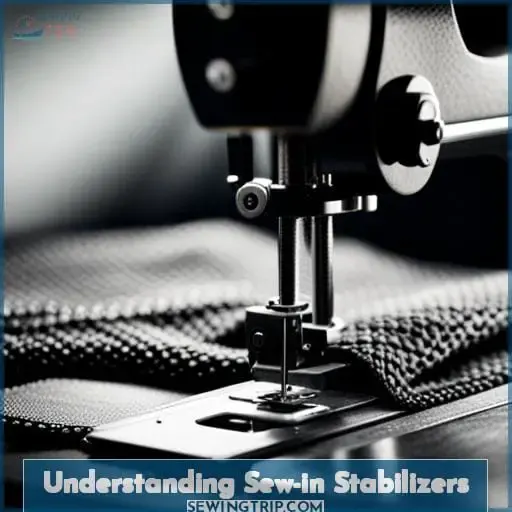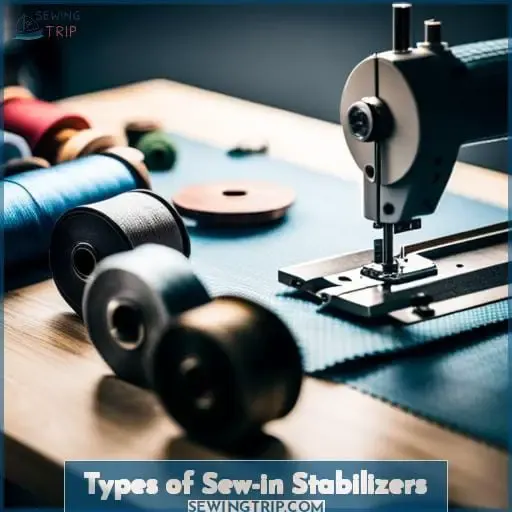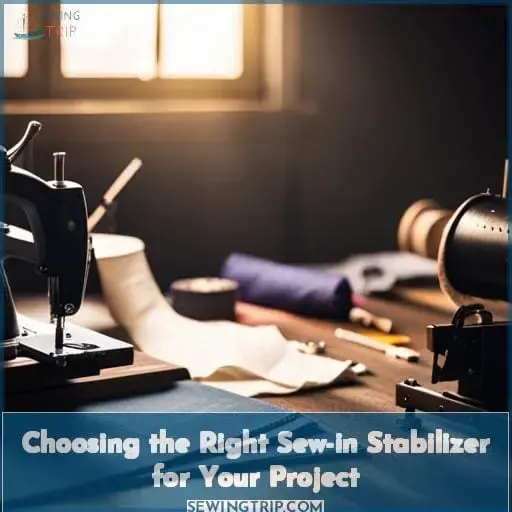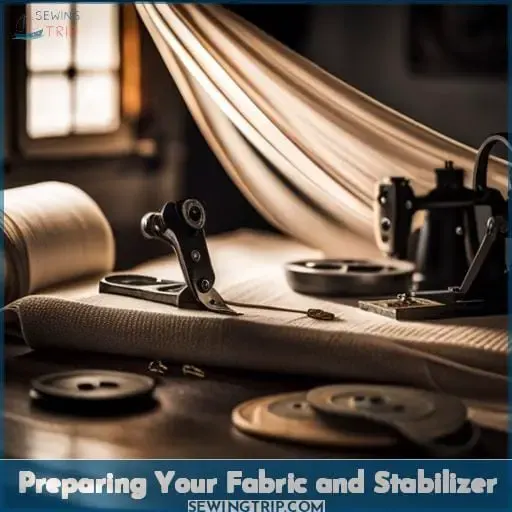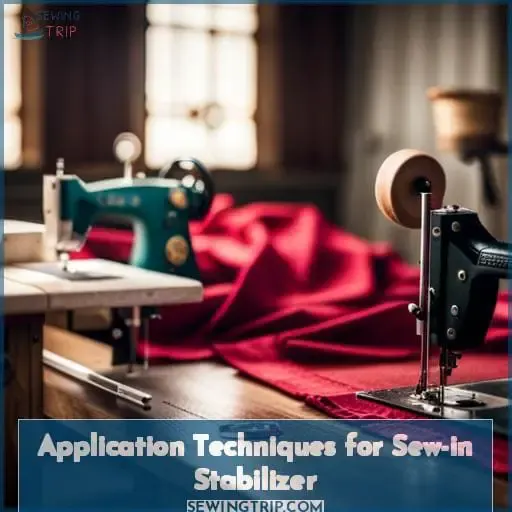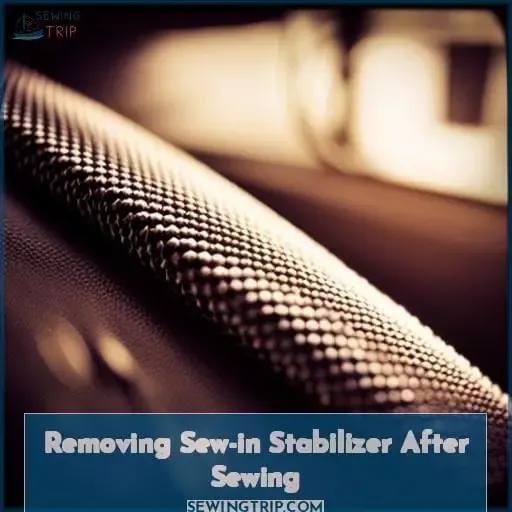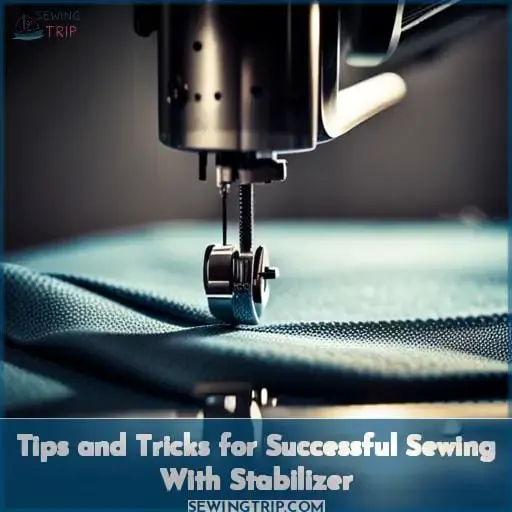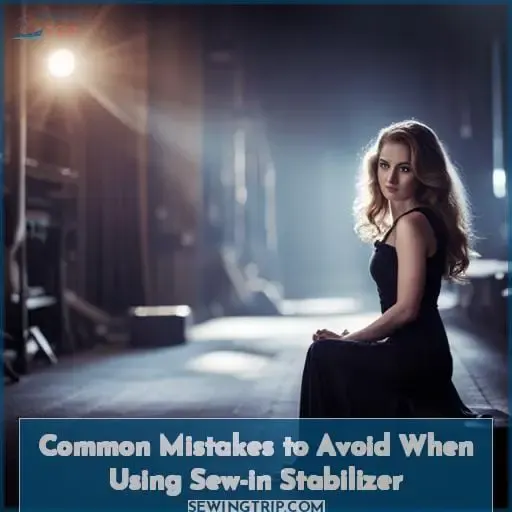This site is supported by our readers. We may earn a commission, at no cost to you, if you purchase through links.
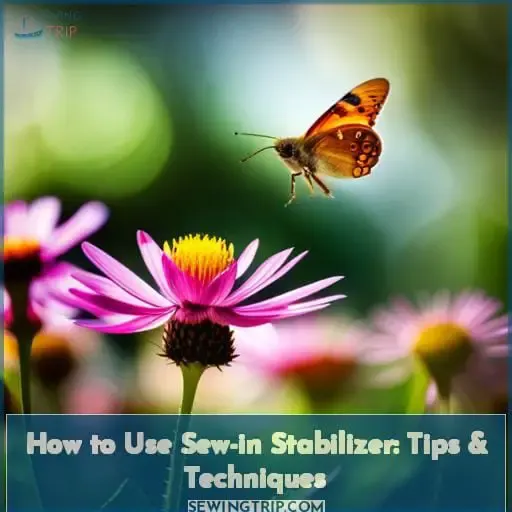 Treading new waters? Sew-in stabilizer can be a tricky beast to master. With the right know-how, however, you’ll have your projects on lockdown in no time.
Treading new waters? Sew-in stabilizer can be a tricky beast to master. With the right know-how, however, you’ll have your projects on lockdown in no time.
Let’s take a deep dive into how to use sew-in stabilizers:
Understanding what they are and what their benefits are.
Exploring the different types of sew-in stabilizers available.
Learning how to choose the right one for your project.
Preparing fabric and stabilizer for application techniques like basting and stitching that will help add extra stability.
Removing it after sewing is complete as well as some helpful tips and tricks along the way.
Ready or not – let’s get started!
Table Of Contents
- Key Takeaways
- Understanding Sew-in Stabilizers
- Types of Sew-in Stabilizers
- Choosing the Right Sew-in Stabilizer for Your Project
- Preparing Your Fabric and Stabilizer
- Application Techniques for Sew-in Stabilizer
- Removing Sew-in Stabilizer After Sewing
- Tips and Tricks for Successful Sewing With Stabilizer
- Common Mistakes to Avoid When Using Sew-in Stabilizer
- Conclusion
Key Takeaways
- Sew-in stabilizers provide internal support, prevent stretching, and enhance fabric drapability.
- When selecting sew-in stabilizers, consider factors such as fiber content, weight, ease of application, affordability, and removability.
- The right sew-in stabilizer depends on variables like fabric type, weight, and your project’s specific needs.
- Choosing stabilizers with appropriate thickness and density helps ensure sturdy embroidery.
Understanding Sew-in Stabilizers
Sew-in stabilizers provide internal structure and support to fabric when sewn directly into a project. They prevent stretching and distortion, enhance drapability, and allow the garment to maintain its shape through wearing and cleaning when utilized properly.
What is Sew-in Stabilizer?
You’ll stabilize your fabric from start to finish when you sandwich it between layers. Sew-in stabilizer remains within projects, providing structure throughout the life of the item.
- Fiber content – Natural or synthetic fibers have different properties.
- Weight – Light vs heavy options offer varying degrees of support.
- Ease of application – Some fuse on, while others require stitching.
- Affordability – Prices range based on quality and quantity needed.
- Removability after sewing – Some can be torn away, while others remain permanent.
Testing your chosen stabilizer first before using it in your sewing or embroidery is wise. Proper preparation prevents poor performance! With the right sew-in stabilizer, your projects will maintain their shape and withstand wear over time.
Benefits of Sew-in Stabilizer
Using sew-in stabilizer provides essential support for the structural integrity of your project, securing its future like a stitch in time. Replenishing a fabric’s structure, sew-ins facilitate precision and prevent distortion.
Unlike tear-away stabilizers, sew-ins become part of the garment, strengthening seams and offering long-term reinforcement. With proper prewashing, trimming, and sewing methods, sew-in stabilizers enable you to construct hardwearing, premium pieces.
Types of Sew-in Stabilizers
When adding support and stability to your sewing projects, sew-in stabilizers are one of the most versatile options available. Both woven and non-woven varieties can be found, with fusible and non-fusible types for different fabric weights and techniques.
Woven Stabilizers
When choosing woven stabilizers, crafters must consider the fabric weight and project specifics to select the appropriate stabilization.
- Woven stabilizers provide structure without bulk.
- They support stitching on lightweight wovens.
- Use a sharp seam ripper to remove excess.
- Ironing woven stabilizer to fabric prevents shifting.
Woven stabilizers offer lightweight support for wovens without impeding the drape or hand of the fabric.
Non-Woven Stabilizers
Non-woven stabilizers, typically made from polyester, nylon, or rayon fibers, are wildly popular for their versatility – over 70% of sewers prefer them for many applications! When selecting sew-in stabilizer, consider your fabric weight and project needs.
Use an appropriate stitch length to secure the stabilizer. Trim excess for maximum stability. Careful preparation and sewing techniques prevent fraying and ensure professional results – sewers love non-wovens! Wildly popular non-woven stabilizers, usually constructed from polyester, nylon, or rayon fibers, offer versatility that over 70% of sewers value for numerous uses.
During selection of sew-in stabilizer, keep fabric weight and project requirements in mind. Utilize proper stitch length when securing the stabilizer. Trimming excess optimizes stability.
Fusible Vs. Non-Fusible Sew-in Stabilizers
Rejoice! You’re a skilled crafter who can discern between fusible and non-fusible stabilizers for flawless embroidery. Fusible stabilizers have adhesive backing to grip fabric for embroidery, while non-fusible types don’t grip but are suitable for many techniques.
Consider your project’s needs when selecting a stabilizer. Fusible aids intricate designs, whereas non-fusible works well for general sewing.
Choosing the Right Sew-in Stabilizer for Your Project
When selecting a sew-in stabilizer for your project, it’s important to first consider the type of fabric and the intended use. For example, when embroidering stretchy fabrics like knits, choose a stabilizer with some stretch such as cut-away, tear-away, or soluble options.
For heavyweight fabrics, opt for a medium to heavyweight cut-away or tear-away stabilizer to support the stitches. In all cases, test different stabilizers on scraps first to ensure suitability for the specific fabric and project needs.
Fabric Type and Weight Considerations
You’ll match lightweight stabilizers to sheer fabrics and heavier options for thick materials. Carefully consider fabric weight and density when selecting the right stabilizer. Sheers and silks pair well with lightweight, sheer stabilizers. Denser fabrics like canvas or denim require sturdy stabilizers that won’t shift during stitching.
Heavier stabilizers also aid thicker threads and prevent density issues in embroidery. Proper stabilizer selection allows your machine to glide smoothly over fabric without drag or damage.
Stabilizer Thickness and Density
Like an anchor securing a ship in stormy seas, you must prudently choose your stabilizer’s thickness to reinforce flimsy fabrics for quality embroidery. Opt for a dense, heavy-duty stabilizer to support lighter material. However, thick stabilizers may overwhelm delicate fabrics – so test samples first.
Achieve the ideal fusion based on fabric type, embroidery design, and desired end product. With experience, you’ll deftly select the perfect stabilizer density for flawless stitching.
Preparing Your Fabric and Stabilizer
Before embroidering, you’ll need to prewash your fabric if it’s not pretreated. Then cut your stabilizer about 2 inches bigger than your hoop size and position it underneath the area to be stitched.
Prewashing Fabric
Preparing your fabric ahead of time by washing it before starting your sewing project helps pre-shrink the fabric and removes any factory chemicals or coatings. Use a mild laundry detergent and wash on the gentle or delicate cycle. Thoroughly dry on low heat or air dry.
For wash-away stabilizers, you can skip prewashing. Also consider the completed project’s care instructions. Will it need to be laundered? Prewash the fabric accordingly for the best long-term results.
Cutting and Positioning Stabilizer
Before draping delicate doilies, diligently determine designated dimensions for dependable, durable stabilizer. Skillful preparers ponder precise positioning, promoting proficient project progression.
- Measure material meticulously.
- Locate layout elegantly.
- Secure stabilizer smoothly.
Passionate perfectionists prepare stabilizers studiously, employing elegant techniques for remarkable results. With steadfast standards, they stabilize fabrics flawlessly. They cut carefully, adhere adequately, and sew sublimely.
Application Techniques for Sew-in Stabilizer
When working with sew-in stabilizer, you’ll need to properly secure it to your fabric. Basting the stabilizer first and using a close zigzag stitch will provide maximum stability for your project.
Basting Stabilizer to Fabric
Once you’ve prepped your fabric and stabilizer, it’s time to join them together – simply baste the two together before you start stitching. Pinning works but can shift during sewing. Instead, use a contrasting thread and long stitches to tack down your stabilizer.
Focus on the edges and middle to secure it flat. This prevents tunneling or shifting that distorts designs. Having basted the pair together, you’ve got a stabilized foundation for beautiful embroidery.
Stitching Techniques for Maximum Stability
Baste your stabilizer in place, then strategically stitch for super stability. Did you know that straight stitching in an X or grid pattern can increase stabilized fabric strength by up to 70 percent? After basting, prepare your fabric by selecting the right needle for your project.
Use zigzag or straight stitches in an X-shape through the fabric and stabilizer. For removable stabilizers, carefully trim excess close to stitching when your project is complete. Before laundering, check if your stabilizer is washable or requires removal. Strategic stitching boosts the sturdiness of stabilized fabric.
Removing Sew-in Stabilizer After Sewing
You’ve finished your sewing project stabilized with the perfect sew-in stabilizer, but how do you remove the excess neatly and properly care for the finished work? Trimming close to stitching and carefully washing or laundering will remove temporary sew-in stabilizers without compromising the structure and appearance of your completed sewing.
Trimming Excess Stabilizer
After securing the fabric and stabilizer, gently snip away excess stabilizer near the stitching. Be mindful not to cut the fabric or threads when removing surplus material. Utilize small embroidery scissors or snips for precision.
Trim stabilizer close to stitching lines and pull away gently. Dispose of scraps thoughtfully, as some stabilizers are not biodegradable.
Washing and Laundering Finished Projects
You’ll love how your projects hold their shape when you gently launder away excess stabilizer. Hand wash or machine wash the projects on delicate, using cold water. Avoid heat from dryers or irons. Check fabric care labels and test inconspicuous areas first. Let the projects air dry fully.
Spot clean the projects as needed and steam them gently to freshen. With proper laundering, your creations will last for years.
Tips and Tricks for Successful Sewing With Stabilizer
When working with stabilizer, proper needle and thread selection along with using multiple layers can make all the difference. Choosing needles and threads suited to the fabric type prevents skipped stitches, puckering, or breakage that ruins projects.
Furthermore, applying two or more layers of stabilizer provides extra support and structure for the best embroidery results.
Proper Needle and Thread Selection
Choosing the right needle and thread for your fabric and project ensures beautiful stitching when working with stabilizer. Pick needles suited to the fabric weight – ballpoint for knits, sharp for wovens.
Polyester thread offers durability and elasticity, while cotton provides a matte finish. Use quality, new needles and thread to prevent skipped stitches and breakage, which distort fabric. Remove pins and needles before final pressing. Well-chosen tools promote efficiency, enhance outcomes, and liberate creativity.
Using Multiple Layers of Stabilizer for Extra Support
Sometimes more is more when your delicate fabric begs for extra stabilizing strength.
- Double the stabilizer on thin, sheer or stretchy fabrics.
- Stack tear-away and cut-away stabilizers for heavy embroidery or dense stitching.
- Reinforce seams with an extra strip for strength and shape retention.
- Add a layer of soluble stabilizer for machine buttonholes on delicate fabrics.
- Use spray adhesive between stabilizer layers to prevent shifting.
Layering stabilizers provides additional support, structure, and stability for your most challenging sewing projects. The extra layers give thin or stretchy fabrics the reinforcement they need. Stacking different types, like tear-away and cut-away, helps heavy embroidery or dense stitching.
Seams stay strong with an extra strip. Soluble stabilizer makes buttonholes easier on delicate fabrics.
Common Mistakes to Avoid When Using Sew-in Stabilizer
When using sew-in stabilizer, it’s common to make mistakes that negatively impact your project. The most frequent errors involve over-stabilizing fabric and neglecting to test stabilizer on scrap material first.
Overdoing stabilizer adds unwanted stiffness and bulk. Failing to test different stabilizers means you risk wasting time and fabric on trial and error.
Overstabilizing Fabric
Using an excessive amount of stabilizer can make your project uncomfortably stiff and awkward to work with. For instance, stabilizing a delicate chiffon blouse with heavy-duty cut-away will likely overwhelm the delicate fabric, restricting movement and making the blouse uncomfortable to wear.
Choosing a stabilizer compatible in weight and texture prevents over-stiffening. Test different thicknesses on scraps to find the right balance of support without compromising wearability and drape.
Neglecting to Test Stabilizer on Scrap Fabric
You’ll rue not testing stabilizer on a scrap first. Skipping this crucial step can ruin your project. Each fabric and stabilizer combo reacts uniquely. Take time beforehand trying stabilizer samples on fabric scraps identical to your project.
Test stitching, fraying, stiffness. Troubleshoot adhesive tack, thickness, tear-away ease. Save headaches, rework, and wasted supplies. Let scraps guide your stabilizer selection and technique.
Conclusion
Practice makes perfect, and this is certainly true when it comes to using sew-in stabilizer for your sewing projects. With the right knowledge and techniques, you can create beautiful garments and fabric items that are strong and durable.
Choosing the right stabilizer for the job, prepping the fabric and stabilizer, and applying the stabilizer correctly are all critical for successful sewing with stabilizer. Once your project is complete, don’t forget to trim away any excess stabilizer and properly launder it for optimal results.
With these tips and tricks, you’ll be ready to tackle any project that requires sew-in stabilizer.

